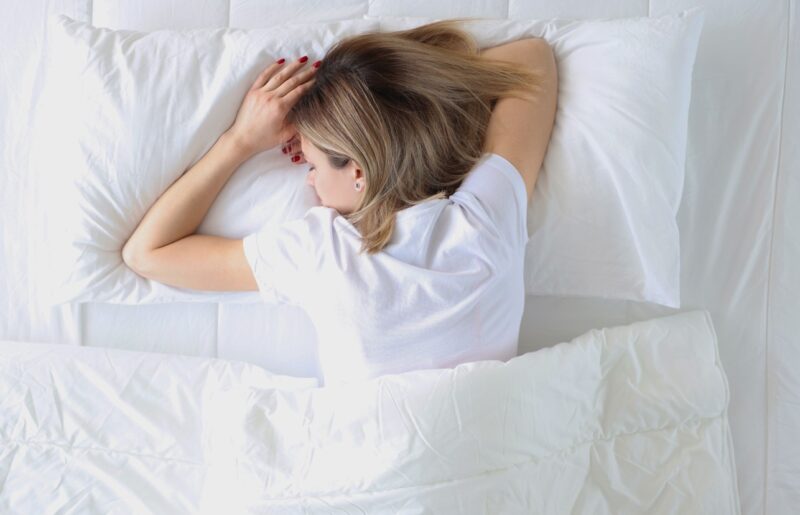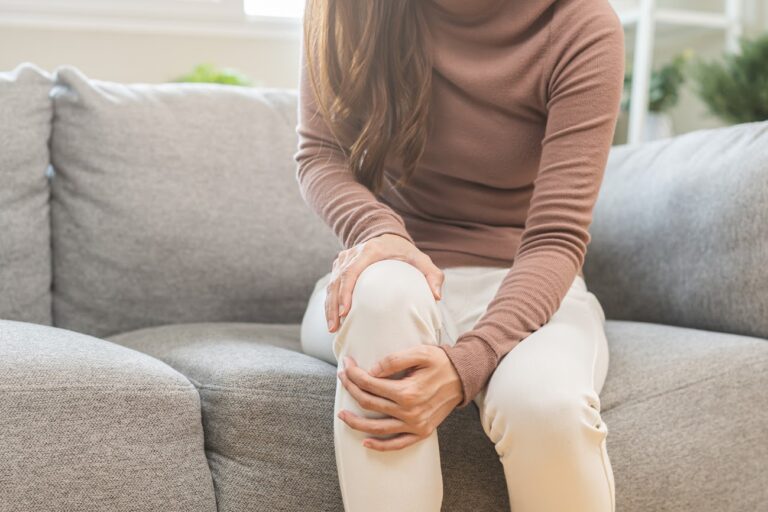Maintaining proper sleeping positions is crucial for joint wellness, especially knee and hip support. Poor sleeping posture can contribute to discomfort and pain and even exacerbate joint issues. Common conditions associated with these issues include osteoarthritis (OA), a degenerative joint disease where protective cartilage wears down, causing night-time discomfort.
Rheumatoid arthritis (RA), an autoimmune disease, can result in chronic joint inflammation and stiffness, impacting sleep during flare-ups. On the other hand, gout, caused by uric acid crystal accumulation, often leads to severe joint pain and sleep disturbances during acute attacks.
Ankylosing spondylitis or inflammatory arthritis affecting the spine, causes stiffness and pain in the hips and lower back, affecting sleep quality. Fibromyalgia involves widespread musculoskeletal pain, fatigue, and tenderness, is associated with sleep disturbances.
Psoriatic arthritis, occurring in some with psoriasis, leads to joint pain and swelling, potentially disrupting sleep. Lupus, an autoimmune disease, may affect joints, contributing to pain and sleep issues.
Bursitis, tendonitis, and degenerative disc disease can cause joint pain and stiffness, affecting sleep. Temporomandibular joint (TMJ) disorders, causing jaw and facial pain, may also disrupt sleep.
Consulting healthcare professionals for proper diagnosis and management, including medications, physical therapy, and lifestyle modifications, is crucial for addressing joint-related pain and sleep disruptions.
Here are some tips for achieving better knee and hip support during sleep:
Back Sleeping

Back sleeping distributes body weight evenly, minimizing pressure points on joints like the hips and knees. It keeps joints in a neutral and relaxed position, particularly beneficial for those with hip arthritis.
Placing a pillow under your knees helps maintain the spine’s natural curve and reduce pressure on your hips. Using a high-quality knee pillow is advisable. Use a thin pillow under your head to keep your neck neutral.
Additionally, back sleeping promotes easier breathing and reduces the risk of airway obstruction during sleep, which can be relevant for those with arthritis-related conditions affecting the spine and chest.
Side Sleeping
Side sleeping is often recommended for individuals with joint problems due to its potential benefits. This sleep position helps maintain proper spinal alignment, particularly when using a pillow between the knees, reducing pressure on the lower back and hips commonly affected by joint issues.
Side sleeping, particularly on the left side, may also improve breathing and reduce the occurrence of acid reflux. The position enhances blood circulation, lowering the risk of numbness and tingling in extremities, which is crucial for joint health.
Additionally, side sleeping distributes body weight evenly across the hips and shoulders, minimizing joint pressure. This can be especially beneficial for those with arthritis or conditions affecting the hip or shoulder joints.
When side sleeping, use a knee pillow to align your hips and relieve stress on your lower back. This is particularly beneficial for hip support. Use a firm pillow to support your neck and keep your spine aligned. Learn more by watching this video.
Fetal Position
The fetal position, a common sleeping posture where a person curls up on their side with knees drawn toward the chest, offers potential benefits for joint health. However, sleep positions are not one-size-fits-all. The fetal position may particularly benefit spinal alignment, reducing stress on the lumbar spine and providing relief for those with lower back pain.
Additionally, sleeping on the side, as in the fetal position, may alleviate snoring and sleep apnea symptoms by keeping airways open. This position also distributes body weight evenly, reducing pressure on joints, which is advantageous for individuals with joint pain or arthritis.
The fetal position can improve blood circulation, promoting overall joint health. Individual comfort and existing health conditions should be considered, and finding a comfortable sleep position that avoids discomfort or pain is crucial.
Regularly changing sleep positions during the night can prevent stiffness and further support joint health. If there are specific concerns or persistent discomfort during sleep, consulting with a healthcare professional for personalized advice is advisable.
If you prefer the fetal position, curl up gently with your knees drawn towards your chest. Place a pillow between your knees for added support.
Stomach Sleeping

Stomach sleeping is a common position that some find comfortable, yet it comes with potential benefits and drawbacks for joint and spinal health. Maintaining natural spinal alignment can be challenging in this position, as the head and neck are often turned to one side, potentially causing strain.
Stomach sleeping may reduce snoring and mild sleep apnea symptoms by keeping the airways more open compared to back sleeping. However, it can pressure joints and muscles, leading to discomfort and pain, particularly in the neck and lower back.
Additionally, some individuals may find it difficult to breathe comfortably in this position, causing sleeplessness. Individual preference is crucial in choosing a sleep position, and if discomfort arises, trying other positions to find better support for joint and spinal health is advisable.
A supportive pillow under the hips or lower abdomen can sometimes alleviate pressure on the lower back. It’s important to be aware of how a chosen sleep position affects comfort and well-being, and if persistent pain occurs, consulting with a healthcare professional for personalized advice is recommended.
How To Promote Sleep Support For Joint Wellness
Choose a good quality mattress that properly supports your body, particularly for the hips and knees. Medium-firm mattresses are often a good choice. Orthopedic pillows can be beneficial, such as those designed for knee or hip support. These pillows are shaped to provide optimal support for specific joints.
Excess weight can stress your joints. Hence, keep the pounds off to relieve the strain on your hips and knees. Regular exercise helps maintain joint flexibility and strength. However, avoid intense workouts close to bedtime. Perform gentle stretching exercises before bedtime to improve flexibility and reduce joint stiffness.
Conclusion

Remember that individual preferences and conditions vary, so finding what works best for you is essential. Experiment with various sleeping positions and pillow arrangements to discover the most comfortable and supportive setup for your knees and hips. If joint pain persists, seek guidance from a healthcare professional for a more tailored approach.

